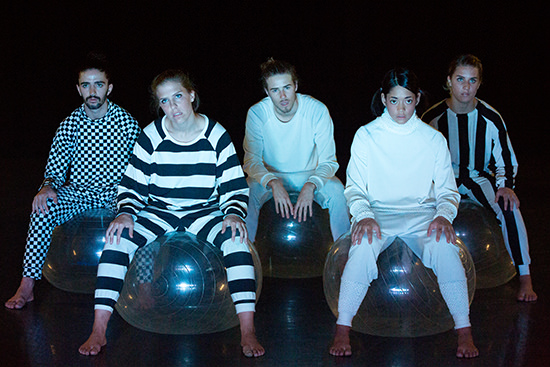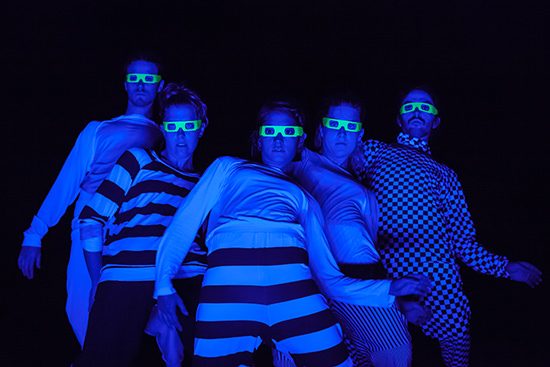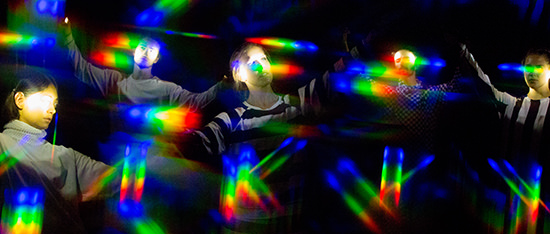Liberating lo-fi for the digital generation
Bernadette Ashley, Dancenorth, Rainbow Vomit

Rainbow Vomit
photographer Amber Haines
Rainbow Vomit
Rainbow Vomit is a joyous romp from beginning to interactive end, transporting the audience for 40 minutes into a childlike state of engagement somewhere beyond the reach of care or distraction. Its brilliance lies in its simplicity—the use of lo-fi elements we all remember the feel and smell of—to peel back the self-conscious veneer of our wordly armour. Dancenorth achieves this without compromising the sophistication of the choreography or patronising its audience in the slightest.
The choreographers, artistic director Kyle Page and rehearsal director Amber Haines, together with the dancers and the company’s cultural engagement staff, delved into research on the effects of digital media technology on developing brains.
The show opens with a voiceover by four-year-old Bella: “When I’m watching TV, my brain feels smooshed, and my body feels sick and lumpy…The back of my neck feels scrapey and itchy when I use my iPad. When I do the iPad, my eyes get stuck open for the whole night and then I get tired the next day…It’s too fun, I can’t stop” (Moving to Learn, exploring the Effects of Technology on Children, 7 May, 2015).
The dancers, who have been sitting, unmoving, in black and white patterned pyjamas on clear bubble-like fitballs as the audience enters, mime the scrolling of hand-held devices to Bella’s words, which echo and distort. They all gaze forwards at a screen’s cold glow, craning their necks from side to side. “Wow,” “Whoah,” they exclaim louder and louder as they rock from side to side on the balls, faster and louder until they are bouncing and laughing, they forget the screen and potential energy becomes kinetic.

Rainbow Vomit
photographer Amber Haines
Rainbow Vomit
The large balls are thrown, balanced on, swapped, compressed, transformed into caterpillars and three-headed monsters, a Mexican wave, as the dancers dissolve and reassemble formations without missing a beat. Lights go out, back on, repeatedly, and each time the balls have changed colour. The audience, comprising all ages from toddler to elderly, responds with oohs and aahs and laughter to these seamless switches.
To music reminiscent of old-school 8bit game sounds, the five dancers form a machine of upended and connected bodies which scoops, passes and quite literally spits ping pong balls, which seem to have appeared from nowhere. There ensues a sort of spitting contest, the dancers attempting to vocalise and sing with the balls in their mouths, looking like sideshow alley clowns for just a moment. The music gets bigger and funkier and they ricochet across the floor ejecting the balls with whole body contractions which lift them off their feet, nailing every hit in Alisdair Macindoe’s soundtrack.
The music slows to a heavier beat with an almost industrial wail, the mood shifts from jolly to ominous. The other dancers begin herding, climbing the scaffolding in slow motion while Jenni Large holds the floor with a low solo of athletic shapeshifting. The crew run and slide as though on the deck of a ship in high waters, heaving from one side of the floor to the other. Mason Kelly’s intense solo has the feel of someone trapped inside a huge pinball game, as the others fade out.
Large and Georgia Rudd reappear in playsuits of splatty electric colours, swaying head to head like conjoined twins, their hair forward and completely hiding their faces. They move, jump and roll in tandem, forming creepy creatures. Harrison Hall joins the blonde movement for a solo with a breathtaking forward slide in which his long hair takes on a life of its own.

Rainbow Vomit
photographer Amber Haines
Rainbow Vomit
The others return with a shiny motorbike helmet. When they place it on Hall’s head, lightning flashes, there is deafening white noise, and he looks as though he’s being electrocuted. They remove it and instantly the sun shines and birds sing. Like a delighted toddler who’s found how switches work, it’s compulsively on and off for a while, then they all move away and the helmet is left floating in the air.
Ashley McLellan next assumes the helmet, and with shifts in the music and lighting, we are briefly in outer space and under water. Hall holds the helmet still, and McLellan’s body ‘hangs’ from the helmet as though she is made of rubber, in the most astonishing, liquid dance. McLellan, freed from the helmet, continues the rubbery isolations with her expressive face, slow-motion girning of the highest order. The audience is in stitches.
From there, Rainbow Vomit segues into its final quarter, in which audience participation becomes key in a totally unexpected way, and the title makes perfect (non)sense. The show has been immediately picked up and will be touring, and it would be unfair to totally blow the premise and deprive future audiences of their moment. Suffice it to say, there are unicorns and a forecast of rainbows, and Page is willing to reveal that it involves kilometres of neon rope.
This show is a rare achievement, a resonant sensory journey into our inner, earlier, less convoluted childhood state. Or, as Bella puts it at the start, “Family game night is better because it doesn’t have any sore or wrinkly feelings.”
–
Dancenorth, Rainbow Vomit, direction, choreography Kyle Page, Amber Haines, performers, co-choreographers Harrison Hall, Mason Kelly, Jenni Large, Ashley McLellan, Georgia Rudd, composer Alisdair Macindoe, lighting, set design Govin Ruben, costumes Andrew Treloar; Townsville School of Arts Theatre, 11-16 April
RealTime issue #132 April-May 2016, web






